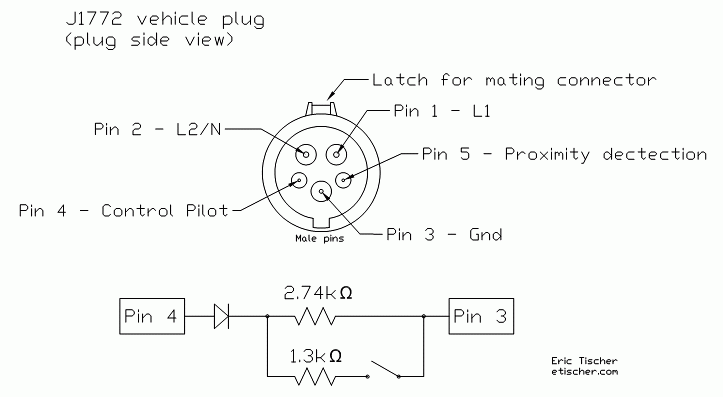occ said:
You'd think it could measure the AC voltage coming in, and also get the Amp rate from J1772 EVSE communication, and get an accurate calculation to display somewhere.
Well, there's no way to measure voltage until it starts flowing juice. But, the EVSE does send the 1kHz square wave to let it know how many amps are available. The Pulse Wave Modulation % determines the amp setting (70% equals 42 amps available to the car).
From Chris Howell's basics of the J1772:
http://code.google.com/p/open-evse/wiki/J1772Basics
Proximity Signal
This is a simple check of either 150 ohms (connected) or 150 + 330 ohms (button pushed to disconnect J1772 nozzle). If 150 ohms are present, the Pilot signal can move from State A to State B, for instance.
Pilot
The J1772 Pilot is a 1khz +12V to -12V square wave, the voltage defines the state and the duty cycle defines the current available to the EV. The EVSE sets the duty cycle and the EV adds resistance from the pilot the Ground to vary the voltage. The EVSE reads the voltage and changes state accordingly.
State -- Pilot Voltage High - Pilot Voltage Low - EV Resistance - Description ----- PWM
State A ---- +12v ------------ N/A --------- N/A ---- Not Connected --- DC
State B ---- +9v ------------ (-12v) ------- 2.74k ---- Connected ----- 1000 Hz
State C ---- +6v ------------ (-12v) -------- 882 ----- Charging ------ 1000 Hz
State D ---- +3v ------------ (-12v) -------- 246 - Ventilation Required - 1000 Hz
State E ------ 0 -------------- 0 ----------- N/A ----- No power ------- N/A
State F ----- N/A ----------- (-12v) --------- N/A ---- EVSE Error ------- DC
Max Current
Up to 51A Amps = Duty cycle x 0.6 Duty cycle = Amps / 0.6
51 - 80A Amps = (Duty Cycle - 64) 2.5
Duty - Max
Cycle - Current
< 3% -- (Error)
3% ---- 7% (Digitial Com Required)
10% --- 6A
20% --- 12A
30% --- 18A
40% --- 24A
50% --- 30A
60% --- 36A
70% --- 42A
80% --- 48A
86% --- 55A
88% --- 60A
90% --- 65A
92% --- 70A
94% --- 75A
96% --- 80A
>96% - (Error)





